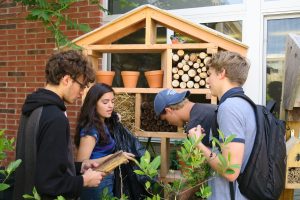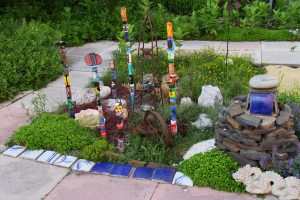Greening Your Schoolyard with Native Plants

To view the photo-rich magazine version, click here.
Originally appears in the Fall 2019 issue.
By Cathy Law
As the green schoolyard movement is taking root, every teacher who has caught the bug faces the same daunting dilemma: garden maintenance. The fall and the winter season is when the school garden slows down and its caretakers can gratefully take a break from the relentless demands of their garden. But before you relax into rejuvenating your spirit (and will) for another year of gardening ahead, why not spend time planning how to save time next growing season by learning low maintenance tips for your garden? You’ll be glad you did!
Most school gardens feature vegetables that reach their grandeur just as the last school bell rings for the year. Temperamental under the best of conditions, vegetable gardens are unforgiving and needy. A huge amount of research has been done on the benefits of gardens for place-based education. Students learn better when they are outdoors enjoying themselves. According to Cornell Garden Based Learning, the benefits of garden-based learning include fostering ecological literacy, stewardship skills and higher exam scores.1 So how do we give our high school and middle school students authentic learning experiences in a school garden, without leaving its caretakers ragged? Perhaps looking to Nature herself is the solution. But you might have to ditch the tomatoes.
Our multi-purpose school garden

For the past 12 years I have developed a school garden using predominately native plants grown in natural sweeps of color, texture, and form. The benefits of not growing vegetables (almost all of which are non-native in my region) is that you can select plants that have adapted to your climate and require a minimum amount of care. I also contend that growing native plants that specifically attract pollinating insects and migrating birds can appeal to a larger audience of curious learners and can present a wider range of potential lab opportunities. Our high school garden, named the Courtyard Gardens, measures 140 by 80 feet with half of the garden covered in paving stones. My students and I have arranged the plantings into themed zones, including scented, culinary, medicinal, touch, butterfly, shade, Zen, and geology gardens. Not only do these zones offer excellent sites for authentic scientific study, but our English, foreign language, art, math, and even social studies teachers enjoy bringing their classes out to the garden to learn. Without a doubt, a garden setting is a fantastic spot for place-based education, but how does one apply nature’s laws to designing a green schoolyard to ensure that the head gardeners spend their free time somewhere other than the school garden?
This content is restricted to subscribers only.
If you are not yet a subscriber, please consider taking out a subscription here.
If you are an existing subscriber, kindly log in or contact us at info@greenteacher.com for more information.





